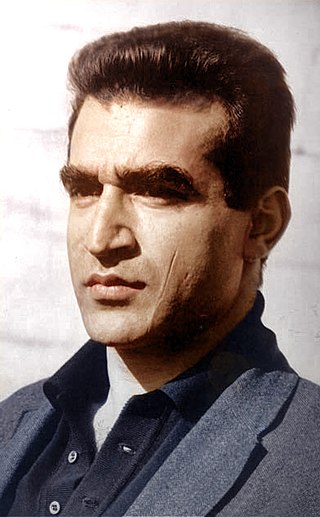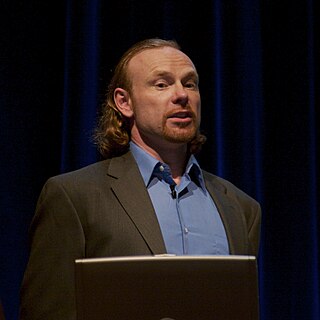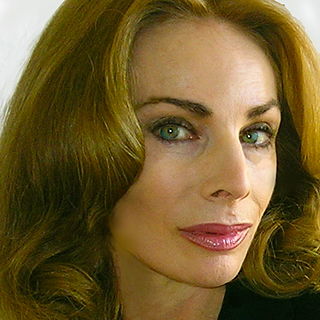
FM-2030 was a Belgian-born Iranian-American author, teacher, transhumanist philosopher, futurist, consultant, and Olympic athlete.
The noosphere is a philosophical concept developed and popularized by the biogeochemist Vladimir Vernadsky and philosopher and Jesuit priest Pierre Teilhard de Chardin. Vernadsky defined the noosphere as the new state of the biosphere, and described it as the planetary "sphere of reason". The noosphere represents the highest stage of biospheric development, that of humankind's rational activities.

Posthumanism or post-humanism is an idea in continental philosophy and critical theory responding to the presence of anthropocentrism in 21st-century thought. Posthumanization comprises "those processes by which a society comes to include members other than 'natural' biological human beings who, in one way or another, contribute to the structures, dynamics, or meaning of the society."
Transhumanism is a philosophical and intellectual movement that advocates the enhancement of the human condition by developing and making widely available sophisticated technologies that can greatly enhance longevity, cognition, and well-being.

Theodosius Grigorievich Dobzhansky was an American geneticist and evolutionary biologist. He was a central figure in the field of evolutionary biology for his work in shaping the modern synthesis and also popular for his support and promotion of theistic evolution as a practicing Christian. Born in the Russian Empire, Dobzhansky emigrated to the United States in 1927, aged 27.
The Omega Point is a theorized future event in which the entirety of the universe spirals toward a final point of unification. The term was invented by the French Jesuit Catholic priest Pierre Teilhard de Chardin (1881–1955). Teilhard argued that the Omega Point resembles the Christian Logos, namely Christ, who draws all things into himself, who in the words of the Nicene Creed, is "God from God", "Light from Light", "True God from True God", and "through him all things were made". In the Book of Revelation, Christ describes himself three times as "the Alpha and the Omega, the beginning and the end". Several decades after Teilhard's death, the idea of the Omega Point was expanded upon in the writings of John David Garcia (1971), Paolo Soleri (1981), Frank Tipler (1994), and David Deutsch (1997).

Max More is a philosopher and futurist who writes, speaks, and consults on emerging technologies. He was the president and CEO of the Alcor Life Extension Foundation between 2010 and 2020.

James J. Hughes is an American sociologist and bioethicist. He is the Executive Director of the Institute for Ethics and Emerging Technologies and is the associate provost for institutional research, assessment, and planning at UMass Boston. He is the author of Citizen Cyborg: Why Democratic Societies Must Respond to the Redesigned Human of the Future and is currently writing a book about moral bioenhancement tentatively titled Cyborg Buddha: Using Neurotechnology to Become Better People.
Many of the tropes of science fiction can be viewed as similar to the goals of transhumanism. Science fiction literature contains many positive depictions of technologically enhanced human life, occasionally set in utopian societies. However, science fiction's depictions of technologically enhanced humans or other posthuman beings frequently come with a cautionary twist. The more pessimistic scenarios include many dystopian tales of human bioengineering gone wrong.

Natasha Vita-More is a strategic designer in the area of human enhancement and life extension. Her interests are located within the ethical uses of science and technology and socio-political implications of revolutionary advances impacting humanity's future.

Mark Alan Walker is a Canadian-American philosopher. He is a professor of philosophy at New Mexico State University, where he occupies the Richard L. Hedden Endowed Chair in Advanced Philosophical Studies. Prior to his professorship at NMSU Prof. Walker taught at McMaster University in the department of philosophy and the Arts & Science Programme. He is the author of Happy-People Pills for All and Free Money for All. Walker founded and was president of the former nonprofit organization Permanent End International (2003–2007), which had been devoted to ending hunger, illiteracy and environmental degradation through the dissemination of modular aquaponics systems for farming. He serves on the editorial board of the Journal of Evolution and Technology and on the board of directors of the Institute for Ethics and Emerging Technologies. He is a former board member of the non-profit organization Humanity Plus.
Body hacking is the application of the hacker ethic in pursuit of enhancement or change to the body's functions through technological means, such as do-it-yourself cybernetic devices or by introducing biochemicals.
Daedalus; or, Science and the Future is a book by the British scientist J. B. S. Haldane, published in England in 1924. It was the text of a lecture read to the Heretics Society on 4 February 1923.

The global brain is a neuroscience-inspired and futurological vision of the planetary information and communications technology network that interconnects all humans and their technological artifacts. As this network stores ever more information, takes over ever more functions of coordination and communication from traditional organizations, and becomes increasingly intelligent, it increasingly plays the role of a brain for the planet Earth. In the philosophy of mind, global brain finds an analog in Averroes's theory of the unity of the intellect

The Phenomenon of Man is an essay by the French geologist, paleontologist, philosopher, and Jesuit priest Pierre Teilhard de Chardin. In this work, Teilhard describes evolution as a process that leads to increasing complexity, culminating in the unification of consciousness. The text was written in the 1930s, but it achieved publication only posthumously, in 1955.
Posthuman or post-human is a concept originating in the fields of science fiction, futurology, contemporary art, and philosophy that means a person or entity that exists in a state beyond being human. The concept aims at addressing a variety of questions, including ethics and justice, language and trans-species communication, social systems, and the intellectual aspirations of interdisciplinarity.

Stefan Lorenz Sorgner is a German metahumanist philosopher, a Nietzsche scholar, a philosopher of music and an authority in the field of ethics of emerging technologies.
The Transhumanist Party is a political party in the United States. The party's platform is based on the ideas and principles of transhumanist politics, e.g., human enhancement, human rights, science, life extension, and technological progress.
The term directed evolution is used within the transhumanist community to refer to the idea of applying the principles of directed evolution and experimental evolution to the control of human evolution. In this sense, it is distinct from the use of the term in biochemistry, which refers only to the evolution of proteins and RNA. Maxwell J. Melhmanh has described directed evolution of humans as the Holy Grail of transhumanism. Oxford philosopher Julian Savulescu wrote that:
Humanity until this point has been a story of evolution for the survival genes - survival and reproduction ... we are entering a new phase of human evolution—evolution under reason—where human beings are masters of their destiny. Power has been transferred from nature to science.
Transhumanist politics constitutes a group of political ideologies that generally express the belief in improving human individuals through science and technology. Specific topics include space migration, and cryogenic suspension. It is considered the opposing ideal to the concept of bioconservatism, as Transhumanist politics argue for the use of all technology to enhance human individuals.










